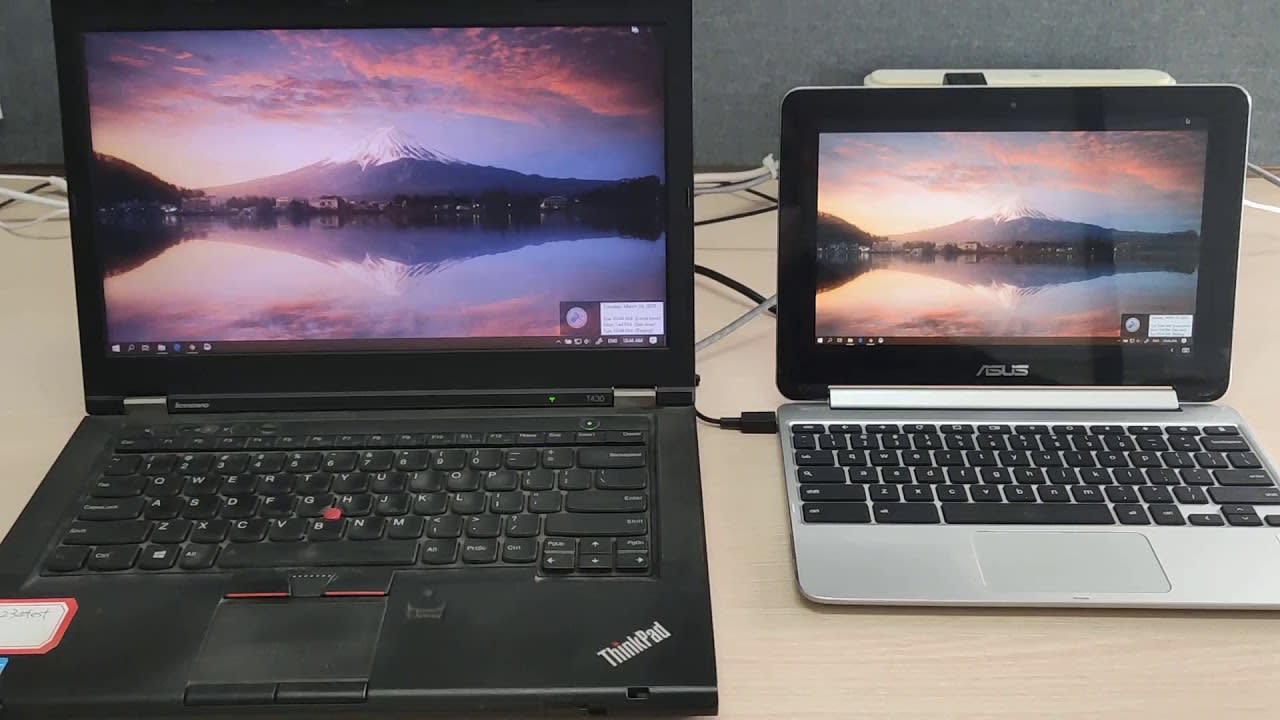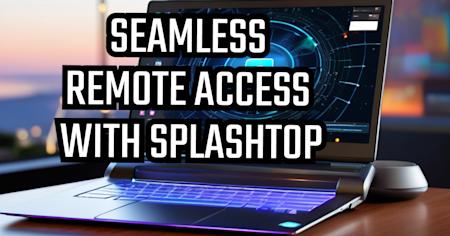Has there ever been a time when you needed to get on your computer right away, but couldn’t because you didn’t have it with you?
There are many scenarios where the cloud just isn’t enough when you can’t physically access your desktop. For example, maybe you need to access a certain file but you can’t upload it to the cloud due to company policy.
Or maybe you need to use a software application that is only available to you on a certain computer. This could be because the software is only licensed to your work computer, or because your desktop is the only workstation powerful enough to run the resource-intensive program you need to use.
No matter the situation, being without your computer while working remotely can greatly hinder your productivity. This makes us wish we could always have our computer available to us wherever we go.
Thankfully, remote access makes that possible without requiring you to take your computer with you. With a remote access tool like Splashtop, you’ll be able to securely access the computer you want to connect to, and remotely control it from another device as if you were using it in person. Entire organizations can leverage this technology to enable work from home. Schools and universities can use it to enhance remote learning.
What is Remote Access?
Remote access is the ability to access a computer or device from another device, at any time, and from anywhere. With remote access software, you have the freedom to access that computer and all its files and applications from another device and control it as if you were sitting in front of it.

Remote access is ideal for:
Accessing resources: Remote access enables users to retrieve files, run applications, and access data stored on another device or network—whether it's at the office, in a data center, or on a personal machine.
Collaboration: Distributed teams can collaborate on projects in real time, share files, and co-edit documents from anywhere. This helps eliminate location-based barriers and supports a more connected workforce.
Whether you're managing devices remotely, supporting clients, or accessing your own workstation while traveling, remote access provides flexibility, efficiency, and control.
Types of Remote Access
Remote access allows users to connect to a computer, network, or system from a different location. While there are several methods available, not all provide the same level of security, efficiency, or ease of use.
1. Direct Network Access (VPNs)
Virtual Private Networks (VPNs) create a tunnel between a remote device and a private network. While commonly used for remote work, they have several downsides:
Can be slow and unreliable, especially over long distances.
Requires complex setup and ongoing maintenance.
Poses security risks if credentials or encryption keys are compromised.
2. Cloud-Based Access
Cloud-based solutions allow users to store and access files and applications via the internet using services like Google Drive or OneDrive. While convenient, they come with limitations:
Limited control over remote systems, making them unsuitable for IT management.
Requires a continuous internet connection to sync and retrieve data.
Not ideal for remote desktop access, IT support, or full system control.
3. Remote Access Software (Best Solution)
Remote desktop access software allows users to control a remote computer as if they were physically present. It offers the best combination of security, performance, and ease of use for businesses, IT teams, and remote workers.
Reasons to choose remote access software:
Provides secure, encrypted access without the complexity of a VPN.
Delivers low-latency performance with high-definition streaming.
Works across multiple devices with an intuitive user experience.
More cost-effective than VPNs and cloud-hosted desktops.
For IT professionals, remote workers, and businesses needing reliable access, remote access tools like Splashtop offers a superior alternative to VPNs and cloud-based solutions by ensuring secure, high-performance remote connections.
Pros and Cons of Remote Access
Pros of Remote Access
Increased Flexibility and Mobility: Remote access allows employees to work from any location, whether they are traveling, working from home, or at a client’s site. This flexibility can lead to increased productivity and job satisfaction.
Cost Savings: By enabling remote work, companies can save on costs associated with office space, utilities, and other overheads. Additionally, employees save on commuting costs and time.
Enhanced Productivity: Tools like remote desktop software enable real-time access to files and applications, making it easier to stay productive.
Improved Business Continuity: In the event of a disaster or unexpected event, remote access ensures that business operations can continue without significant disruptions. Employees can access their work environment from safe locations, maintaining productivity.
Access to a Wider Talent Pool: Companies are not limited to hiring local talent. With remote access, they can recruit the best candidates from anywhere in the world, bringing diverse skills and perspectives to the team.
Better Work-Life Balance: Remote access allows employees to work from anywhere, reducing commute time and providing greater flexibility. This leads to less stress and improved overall well-being.
Improved Collaboration: Teams can access shared systems, files, and applications in real time from different locations. This enhances productivity and enables seamless teamwork across geographies.
Faster Response Times: IT teams can resolve technical issues quickly by remotely accessing devices. This eliminates the need for on-site visits and minimizes downtime.
Scalability: Remote access solutions can scale easily as your business grows. Adding new users or devices is simple, making it ideal for growing teams and distributed operations.
Cons of Remote Access
Security Risks: Remote access can expose sensitive data to potential security threats if not properly managed. It's crucial to implement strong security measures, such as encryption, multi-factor authentication, and regular updates to prevent unauthorized access.
Technical Issues: Dependence on internet connectivity means that technical issues such as slow speeds, outages, or connectivity problems can hinder remote work. This can lead to frustration and reduced productivity.
Isolation and Communication Challenges: Remote work can sometimes lead to feelings of isolation among employees. Communication can also be challenging without face-to-face interactions, potentially leading to misunderstandings or miscommunications.
Management and Supervision: Supervising remote employees can be more challenging compared to in-office staff. Managers need to adapt their management style to ensure that remote workers are staying productive and engaged.
Dependence on Technology: Remote access relies heavily on technology and the availability of remote access tools. Any malfunction or downtime in these tools can disrupt work and delay projects.
By weighing these pros and cons, organizations can better prepare for the challenges and benefits of remote access, ensuring a smoother transition and more effective remote work practices.
Remote Access Examples & Case Studies
Enabling Remote Work
S.J. Pockmire’s experience working at both the Moore County Historical Association and Vintage Soapworks demonstrates how remote access can overcome geographic constraints. Previously limited by the need to work at a specific historical site, Pockmire found flexibility with Splashtop. This technology allowed her to access crucial documents from a more comfortable, home-based office.
For Vintage Soapworks, remote access facilitated the design of product labels from home, followed by easy file transfer for printing. This use case underscores the benefit of remote access in enabling remote work without the need to be physically present at a work location, significantly enhancing efficiency and work-life balance.
Here’s a video showing how you could use a Chromebook for remote pc access to a Windows computer to work remotely:

Note: Splashtop Business Access is now called Splashtop Remote Access. The product name has changed, but the features and functionality remain the same.
Providing Remote Technical Support
Remote desktop tools can also be a great tool for IT, help desks, and MSPs to provide remote support. Technicians could simply launch a remote connection to their user’s device to take control and fix an issue, without needing to physically travel to the device.
Audio Perception, a Los Angeles-based audio technology firm, was faced with the challenge of providing support and services during the COVID-19 pandemic. They leveraged Splashtop to offer screen sharing, design presentations, and technical assistance, regardless of their client's locations. This case illustrates how remote access can be used to maintain business continuity, expand service reach beyond physical boundaries, and provide high-quality, real-time support in sectors where on-site presence isn't always feasible.
Enhancing Remote Learning
The Career and Technical Education division at Laney College hosts several computer labs that provide students with the high-powered software they use in their academic courses. Laney College leverages Splashtop to enable students to remotely access lab computers, from their own devices, even Chromebooks. This enables students to enjoy the same educational experience and access the same resources even when they are not on campus. Students and instructors have been very pleased with the results thus far.
The Importance of Secure Remote Access
As more businesses and individuals rely on remote access to stay productive, security must be a top priority. Unsecured remote access can expose systems to cyber threats like unauthorized logins, data breaches, and ransomware attacks. Threat actors often exploit weak authentication, open RDP ports, and outdated VPN configurations to gain access to sensitive information.
Ensuring secure remote access requires strong encryption, multi-factor authentication (MFA), and strict access controls. Traditional methods like VPNs and basic RDP connections often lack the necessary security layers, putting businesses at risk.
A robust remote access solution, like Splashtop, provides enterprise-grade encryption, granular permissions, and advanced security features to safeguard remote sessions. By prioritizing security, organizations can protect critical data, prevent cyberattacks, and ensure compliance with industry regulations—all while enabling seamless remote work and IT support.
How Does Remote Access Work?
So how can you control your remote computer from anywhere? Each solution is different, but generally, all work in similar ways.
Remote Access User Guide
First there’s the software. Once you get started with your remote access software, you’ll need to download and install the necessary applications on any computer that you want to remote to and on any computer or mobile device that you want to remote from.
Once the apps are installed, you can open the app on the device you’re remoting from and choose to connect to the computer you want to remote to. As long as that computer isn’t shut down and has access to the internet, you’ll be able to connect instantly.
Keep in mind that each tool will work slightly differently and have their own set of features and pricing.
If you want to see how Splashtop works, check out this guide on how to access a computer remotely.
Next, let’s take a look at the best solutions for individuals, organizations, and education.
How to Choose the Right Remote Access Solution?
Selecting the appropriate remote access solution for your organization is crucial for ensuring security, productivity, and seamless workflow. Here are key factors to consider when choosing the right remote access tool:
1. Security Features
Security should be the top priority when evaluating remote access solutions. Look for features such as:
End-to-End Encryption: Ensure that the solution provides robust encryption to protect data during transmission.
Multi-Factor Authentication (MFA): MFA adds an extra layer of security, reducing the risk of unauthorized access.
Access Controls: The ability to define and manage user permissions helps ensure that only authorized personnel can access sensitive information.
Regular Updates and Patches: Choose a solution that is frequently updated to address new security vulnerabilities.
2. Compatibility and Integration
The remote access solution should be compatible with the devices and operating systems used by your organization. Consider the following:
Cross-Platform Support: Ensure the tool supports various operating systems such as Windows, macOS, Linux, iOS, and Android.
Software Integration: The ability to integrate with existing applications and software can streamline workflows and improve productivity.
3. Ease of Use
A user-friendly interface is essential for both IT administrators and end-users. Evaluate:
Simple Setup and Configuration: The solution should offer easy installation and configuration processes.
Intuitive User Interface: A straightforward interface reduces the learning curve and minimizes the need for extensive training.
Customer Support: Reliable customer support can assist with troubleshooting and ensure a smooth user experience.
4. Performance and Reliability
The remote access solution should deliver high performance and reliability to avoid disruptions in workflow. Consider:
Connection Stability: Look for a solution that provides stable and fast connections, even in low-bandwidth environments.
Scalability: Ensure the tool can scale with your organization’s growth, accommodating more users and devices as needed.
Downtime and Maintenance: Evaluate the provider’s track record for uptime and how they handle maintenance and updates.
5. Cost-Effectiveness
The cost of the remote access solution should align with your budget while providing the necessary features. Consider:
Pricing Plans: Compare the pricing plans of different solutions to find one that offers the best value for your needs.
Licensing: Understand the licensing terms, including the number of users, devices, and any additional fees.
Free Trials and Demos: Utilize free trials and demos to evaluate the solution before making a financial commitment.
By carefully considering these factors, you can choose the right remote access solution that meets your organization's security requirements, integrates well with your existing systems, and provides a user-friendly and reliable experience for your team.
Remote Access Software for Individuals, Businesses, and Education
Splashtop offers fast and secure solutions covering all types of use cases. Whatever the reason you need remote access, Splashtop has you covered.
Best Solution for Individuals, Teams, and Organizations to Enable Remote Working
If you (or your team) want to be able to remotely access your work computers from anywhere at any time, then Splashtop Remote Access is the solution for you.
Use Splashtop Remote Access to securely remote into your Windows, Mac, or Linux computer. You can remote from any computer, tablet, or smartphone device that runs on Windows, Mac, iOS, Android, and Chromebook operating systems.
Splashtop Remote Access is great at helping you stay productive with tools like remote print, drag-and-drop file transfer, multi-monitor support, and remote wake. You can control your work computer in real-time, with high-definition quality and remote sound.
If this sounds right for you, you can learn more about Splashtop remote access for work from home and start a free trial now.
Best Solution for Education
Give students access to school lab computers so they can take advantage of school computing resources and software while distance learning! Read more about remote access for education.
Best Solution for Help Desks & IT Support
If you want to support any of your users’ devices remotely, the moment they need help, check out a remote support solution like Splashtop Remote Support.
With Splashtop Remote Support, you can access any Windows, Mac, iOS, or Android device with a simple session code. You’ll be able to provide attended support to an unlimited number of devices and also be able to add unattended access to your managed computers.
Best All-in-One Solution for Enterprises
Want to provide your workforce with remote access to enable remote working and also give your IT team the ability to remotely support any device? Check out Splashtop Enterprise!
Ensuring Secure Remote Access for Your Business with Splashtop
Splashtop offers a secure remote access solution tailored to protect your business data while ensuring seamless connectivity. Here’s how Splashtop safeguards your remote access:
Advanced Encryption: All remote sessions are protected with end-to-end AES 256-bit encryption, keeping your data secure from potential threats.
Multi-Factor Authentication (MFA): MFA adds an extra layer of security by requiring multiple verification methods for user access.
Granular Access Controls: Administrators can set specific access levels for users, ensuring that employees only access necessary resources.
Comprehensive Logging and Monitoring: Detailed logs and real-time monitoring help identify and address unusual activities promptly.
Regular Security Updates: Splashtop receives frequent updates to address new vulnerabilities and enhance security features.
Secure File Transfer: Encrypted file transfers between remote and local devices ensure data remains protected during transit.
Session Timeout and Idle Detection: Automatic session termination after inactivity reduces the risk of unauthorized access.
Choose Splashtop for a secure and efficient remote access solution that protects your business data and supports seamless remote work.
Get Started with Splashtop - Maximize Efficiency with Remote Access Software
Want to use your computer from anywhere without having to take it with you? Learn more about Splashtop, or get started with a free trial now to enjoy remote PC control on your computers! No commitment or credit card is required.





